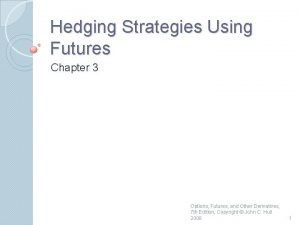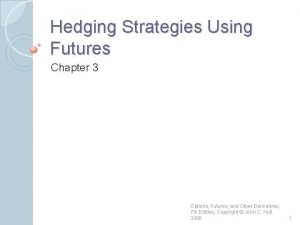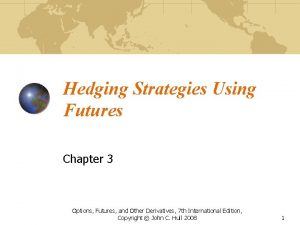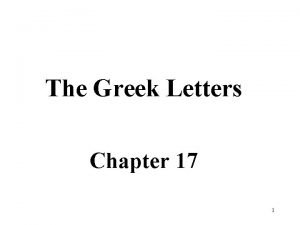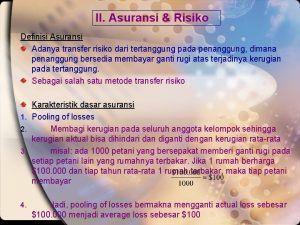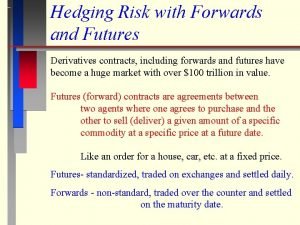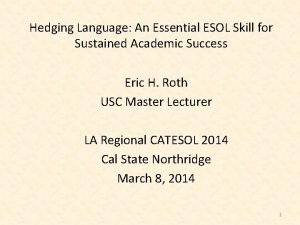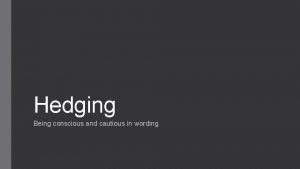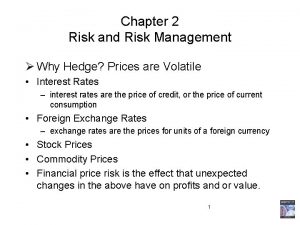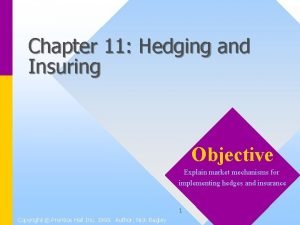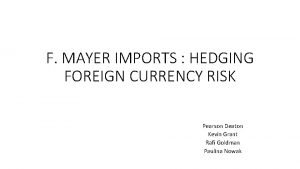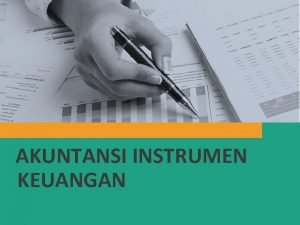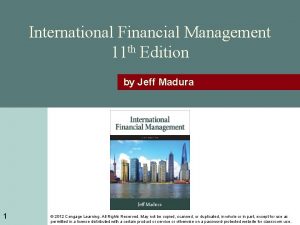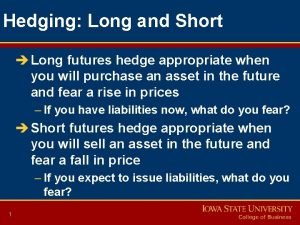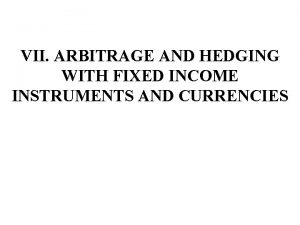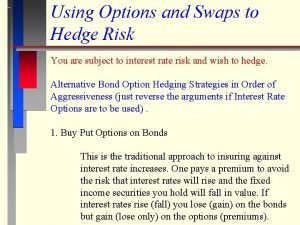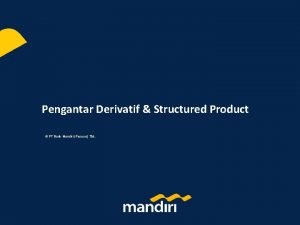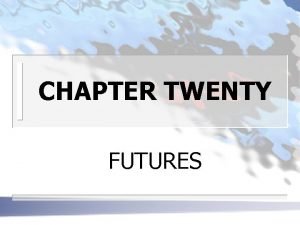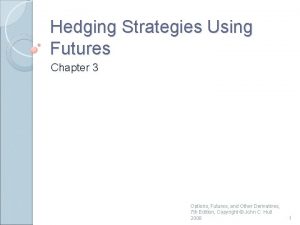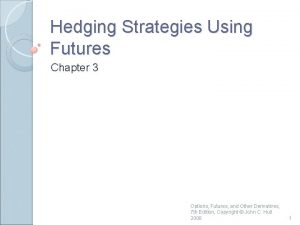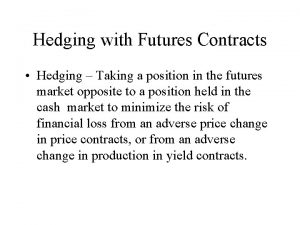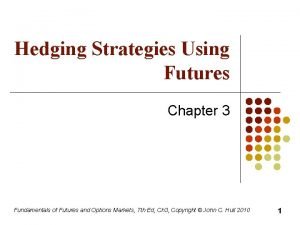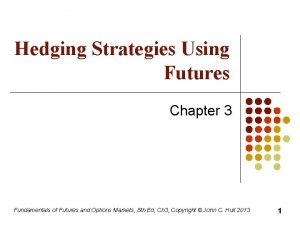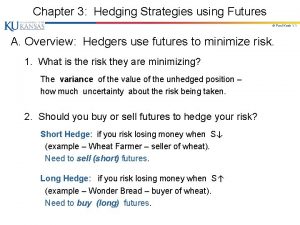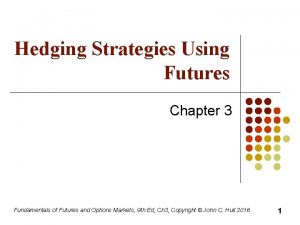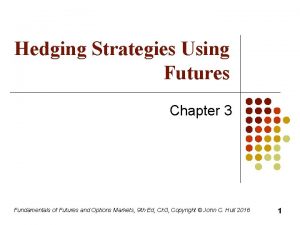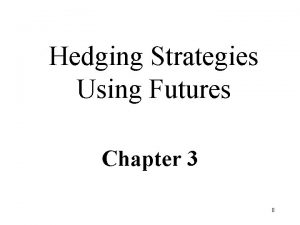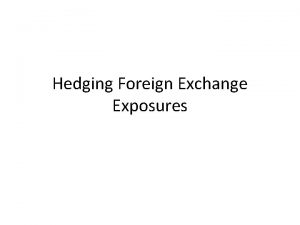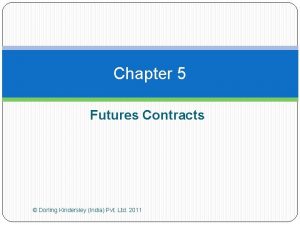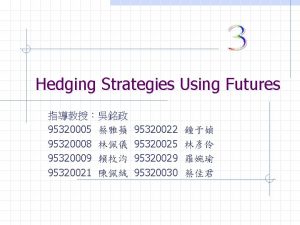Chapter 6 Hedging Strategies Using Futures 2011 Dorling


































- Slides: 34

Chapter 6 Hedging Strategies Using Futures © 2011 Dorling Kindersley (India) Pvt. Ltd

Objectives of the Chapter � Understanding why people hedge using futures � What is a long hedge? � What is a short hedge? � When should hedging be undertaken? � What are the risks in hedging? � What is basis risk? � What is the optimal hedge ratio? © 2011 Dorling Kindersley (India) Pvt. Ltd

Principles of Hedging A party faces a loss when the price of some asset changes—they want to reduce this loss by trading futures contracts Hedging is done to lock in a price at the current time for a future transaction Hedging helps in forecasting future cash flows with some certainty © 2011 Dorling Kindersley (India) Pvt. Ltd

Perfect and Imperfect Hedges A perfect hedge is achieved when price uncertainty is fully eliminated and the hedger knows for certain what the future cash flow will be An imperfect hedge is a partial hedge in which the price uncertainty is reduced but not fully eliminated © 2011 Dorling Kindersley (India) Pvt. Ltd

Issues in Hedging �What quantity of assets would be subjected to loss if the price changes? �When would losses accrue, i. e. when prices increase or decrease? �What futures contract would provide a hedge against this loss? �How many futures contracts would be needed to hedge? © 2011 Dorling Kindersley (India) Pvt. Ltd

Deciding the Hedge The hedger needs to decide the type of hedge, depending upon whether increases or decreases in the asset price will result in a loss Under a hedge, any loss arising from the asset would be compensated by gain from the futures contract The hedger will take an opposite position to the position he has in the asset © 2011 Dorling Kindersley (India) Pvt. Ltd

Hedging Commodity Price Risk I � When commodity price is likely to increase, the producer of commodities will benefit, whereas the users will face a loss � Thus, a trader who needs to buy some commodity at a future time, or who has a short position in the commodity, will face a downside risk � This can be hedged by the trader by taking a long position in futures, i. e. by agreeing to buy the commodity at a future time at a known price � This is known as a long hedge © 2011 Dorling Kindersley (India) Pvt. Ltd

Hedging Commodity Price Risk �When commodity prices are likely to decrease, the producers will face a loss, and the users a gain �A trader who owns a commodity and plans to sell it at a future time, or who has a long position in the asset, faces a downside risk �Downside risk can be hedged by taking a short position in futures, i. e. by agreeing to sell the commodity at a future time at a known price �Known as short hedge © 2011 Dorling Kindersley (India) Pvt. Ltd

Hedging Currency Risk I � When exchange rate moves against a trader, he will engage in hedging � For an importer who needs to make foreign currency payments, downside risk arises when foreign currency is expected to appreciate � Downside risk can be hedged by taking a long position in the foreign currency future by agreeing to buy foreign currency at a known exchange rate � This is a long hedge © 2011 Dorling Kindersley (India) Pvt. Ltd

Hedging Currency Risk II �An exporter who would receive a foreign currency cash flow at a future time faces a downside risk of the foreign currency depreciating �Downside risk can be hedged by taking a short position in the currency futures by agreeing to sell the foreign currency at a future time at a known rate �This is a short hedge © 2011 Dorling Kindersley (India) Pvt. Ltd

Hedging Interest Rate Risk �Interest rate risk affects borrowers and investors �A borrower faces downside risk if the interest rate increases, while an investor faces downside risk if the rate decreases �Hedging strategy depends on whether the interest rate futures are written on the interest rate itself, such as on Eurodollar futures, or on instruments such as a government bond © 2011 Dorling Kindersley (India) Pvt. Ltd

Hedging Interest Rate Risk II If futures are on interest rates themselves, like in Eurodollar futures, a borrower would take a long position in these futures locking in a known interest at the current time—this is a long hedge An investor would take a short position in these futures, locking in a known interest rate, which is a short hedge © 2011 Dorling Kindersley (India) Pvt. Ltd

Hedging Interest Rate Risk III � If futures are on an instrument such as a government bond, � The price of the bond will decrease when interest rates increase. If the price is expected to decrease, a short position in futures or short hedges are applicable. Therefore, a borrower should go for a short hedge using government bond futures � The price of the bond will increase when interest rates decrease. If the price is expected to increase, a long position in futures, or a long hedge, is applicable. Therefore, an investor would go for a long hedge while using government bond futures © 2011 Dorling Kindersley (India) Pvt. Ltd

Long Hedge � A long hedge is one in which the hedger has a short position in an asset and takes a long position in futures �Traders who need to buy the asset at a future time will use long hedge through commodity futures �Importers who need to buy foreign currency at a future time will use long hedge through currency futures �Borrowers who need to borrow at a future time will use long hedge through interest rate futures �Investors who need to invest at a future time will use long hedge through government bond futures © 2011 Dorling Kindersley (India) Pvt. Ltd

Short Hedge � Short hedges are ones in which hedgers take a long position in assets and a short position in futures �Traders who own the asset now and need to sell at a future time will use short hedge through commodity futures �Exporters who will receive foreign currency cash flows at a future time will use short hedge through currency futures �Investors who need to invest at a future time will use short hedge through interest rate futures �Borrowers who need to borrow at a future time will use short hedge through government bond futures © 2011 Dorling Kindersley (India) Pvt. Ltd

Example of Hedging I �A rice merchant estimates that he will require 50 MT of rice on July 31. �Since he needs to buy rice at a future time, he will enter into a long hedge in rice futures for a total value of 50 MT �If the futures price on May 1 is INR 50, 000/MT, he will pay 50, 000*50 = INR 2, 500, 000 on July 31 and receive 50 MT of rice © 2011 Dorling Kindersley (India) Pvt. Ltd

Example of Hedging II �On January 1, a producer of steel ingots estimates that he will need to sell 30 MT of steel on March 31 �Since he must sell steel at a future time, he will enter into a short hedge for a total value of 30 MT �If the steel ingot futures price on Jan 1 is INR 45, 000/MT, he will need to provide 30 MT of steel ingots and receive INR 13, 500, 000 on March 31 © 2011 Dorling Kindersley (India) Pvt. Ltd

Example of Hedging III On Jan 1, an importer buys goods from the USA for USD 1 million, to be paid on March 31 Since he needs to buy USD on March 31, he will enter into a long hedge to buy USD futures If the futures price is INR 45. 30, the importer will pay INR 45. 3 million and receive USD 1 million © 2011 Dorling Kindersley (India) Pvt. Ltd

Example of Hedging IV On March 1, an exporter sells goods to Germany for EUR 800, 000, on which payment will be made on March 31. Since he needs to sell EUR on March 31, he would enter into a short hedge (Sell future) on EURO futures If the futures price is INR 56. 50, the exporter will receive INR 45. 2 million © 2011 Dorling Kindersley (India) Pvt. Ltd

Perfect Hedge � A hedge, whether long or short, is considered as a perfect hedge if the cash flow that is to be paid or received at the future time is known with certainty at the current time � In a perfect hedge, any loss or gain from the underlying asset position will be exactly offset by gains or losses from the future � The price that will be either paid or received will be the same as the futures price contracted, irrespective of the price movement of the underlying asset © 2011 Dorling Kindersley (India) Pvt. Ltd

Example of Perfect Long Hedge I On Jan 1, the spot price of rice is INR 30/kg The March futures price of rice is INR 33/kg A merchant enters into a long hedge, taking a long position in futures, agreeing to buy the rice at INR 33/kg on 31 March On 31 March, the spot price of the rice is INR 35/kg, and the futures price is INR 35/kg © 2011 Dorling Kindersley (India) Pvt. Ltd

Example of Perfect Long Hedge II �You close the position on March 31 by agreeing to sell rice at INR 35/kg, and buy rice at INR 35/kg in the spot �Gain from futures = INR 2/kg �Net cost = price paid – gain from futures = INR 33/kg �Same as futures price contracted on Jan 1 © 2011 Dorling Kindersley (India) Pvt. Ltd

Example of a Perfect Short Hedge I On April I, the spot price of dal is INR 2000 /quintal The April futures price of dal is INR 2100/quintal The producer of dal enters into a short hedge to sell dal on April 30 On April 30, the spot and futures price are INR 1950/quintal © 2011 Dorling Kindersley (India) Pvt. Ltd

Example of a Perfect Short Hedge II The hedger closes the position on April 30, agreeing to buy dal at INR 1950/quintal, and sells in the spot at INR 1950 The net revenue is the price received - gain from futures = 1950 + (2100 – 1950) = INR 2100 Same as the futures price contracted on April 1 © 2011 Dorling Kindersley (India) Pvt. Ltd

When to Hedge? �Hedging is undertaken to reduce price uncertainty and protect the hedger from downside risk �A long hedge is appropriate only if the price is expected to increase (hedge downside risk) �A short hedge is appropriate only if the price is expected to decrease (hedge downside risk) �Decision to hedge is based on expectations of price movement © 2011 Dorling Kindersley (India) Pvt. Ltd

Risks in Hedging � Price movement is opposite to what was expected (upside risk), which can result in losses � One does not get perfect hedges if any of the following conditions hold: �Asset to be hedged is different from the underlying f asset in the futures �The quantity to be hedged is different from the futures size �The end of exposure date of the asset is different from the maturity date of the futures © 2011 Dorling Kindersley (India) Pvt. Ltd

Basis and Basis Risk �Basist = spot price of asset to be hedged (St) – futures price of contract used (Ft) �Initial basis is basis on the day the contract is entered into (S 0 – F 0) �Final basis (ST – FT) is basis on the maturity date �Final basis should be zero if the asset to be hedged is the same as the asset underlying the futures �If the final basis is not zero, basis risk exists © 2011 Dorling Kindersley (India) Pvt. Ltd

Basis Risk and Imperfect Hedge For long hedge, Gain from futures: (FT – F 0) Final price paid: ST – (FT – F 0) = (ST – FT) + F 0 For short hedge, Gain from futures: (F 0 – FT) Final price received: ST + (F 0 – FT) = (ST – FT) + F 0 © 2011 Dorling Kindersley (India) Pvt. Ltd

Characteristics of Basis Risk Basis risk is smaller for investment assets such as stock futures, currency futures and metal futures, as compared to commodity futures If basis risk strengthens, a short hedger will benefit, whilst a long hedger will only benefit if the basis weakens © 2011 Dorling Kindersley (India) Pvt. Ltd

Factors Affecting Basis Risk a. Asset being hedged is different from the futures underlying the asset b. The day on which the hedge is closed out is different from the futures maturity date c. The quantity of the asset being hedged is not fully covered by an integer multiple of futures contracts © 2011 Dorling Kindersley (India) Pvt. Ltd

Examples of Basis Risk � An exporter expects to receive AUD 546, 288 on Oct 14. � Futures are not available on AUD and hence will use USD futures. The final basis need not have to be zero as ST = spot price of AUD, whereas FT = spot price of USD � USD futures are available with maturities of Sep 30 and Oct 31. Mismatch of timing of hedge being closed out and futures maturity date. � The USD futures contract size is USD 1000. Since a complete hedge requires 546. 288 contracts, there is a mismatch of quantity to be hedged and contract size © 2011 Dorling Kindersley (India) Pvt. Ltd

Hedge Ratio Size of exposure = quantity of asset * spot price of asset Size of position in futures = contract size * number of contracts © 2011 Dorling Kindersley (India) Pvt. Ltd

Example of Using Hedge Ratio � A company requires 20 tonnes of wheat on March 20. On March 1, wheat sells at INR 1200/100 kg, and March futures are at INR 1240. The contract size for futures is 10 tonnes. � σS = 100, σF = 70, r = 0. 98 � Size of exposure = 20 * 1200 * 10 = 240, 000 � Futures value = 10 * 1240 * 10 = 124, 000 � Number of contracts = 0. 98 * (240, 000/124, 000) = 1. 9 ≈ 2 � Take a long position in 2 contracts © 2011 Dorling Kindersley (India) Pvt. Ltd

Static and Dynamic Hedging In static hedging, a contract will be held until maturity if the end-of-exposure date is the same as that of the maturity date, and close to the end of exposure date if the maturity is after the end-ofexposure date. In dynamic hedging, the hedger will observe price movements and thereby periodically change the hedge ratio. © 2011 Dorling Kindersley (India) Pvt. Ltd
 Derivatives hedging strategies
Derivatives hedging strategies Hedging strategies using futures
Hedging strategies using futures Hedge ratio
Hedge ratio Hedging strategies using futures and options
Hedging strategies using futures and options Hedging interest rate risk with futures
Hedging interest rate risk with futures Cattle hedging strategies
Cattle hedging strategies What are the features of academic writing?
What are the features of academic writing? Hedging in academic writing exercises
Hedging in academic writing exercises Delta neutral hedging in surat
Delta neutral hedging in surat Hedging adalah
Hedging adalah Fed tapering
Fed tapering Hedging in academic writing
Hedging in academic writing Hedging adalah
Hedging adalah Hedging and boosting
Hedging and boosting What is cautious language
What is cautious language Hedging manages risk that are manageable
Hedging manages risk that are manageable Main objective of hedging
Main objective of hedging F. mayer imports: hedging foreign currency risk
F. mayer imports: hedging foreign currency risk Hedged item and hedging instrument examples
Hedged item and hedging instrument examples Oil hedging definition
Oil hedging definition Hedging receivables and payables
Hedging receivables and payables Manfaat instrumen derivatif untuk hedging
Manfaat instrumen derivatif untuk hedging Short and long hedge
Short and long hedge Hedging approach of working capital
Hedging approach of working capital Fixed income hedging
Fixed income hedging Hedging credit risk with options
Hedging credit risk with options Contoh structured product bank
Contoh structured product bank What is futures trading
What is futures trading Static hedging of exotic options
Static hedging of exotic options 005930 keuangan
005930 keuangan Definition of futures contract
Definition of futures contract Cheapest to deliver
Cheapest to deliver Euro btp future
Euro btp future Futures contracts
Futures contracts Interest rate futures
Interest rate futures
